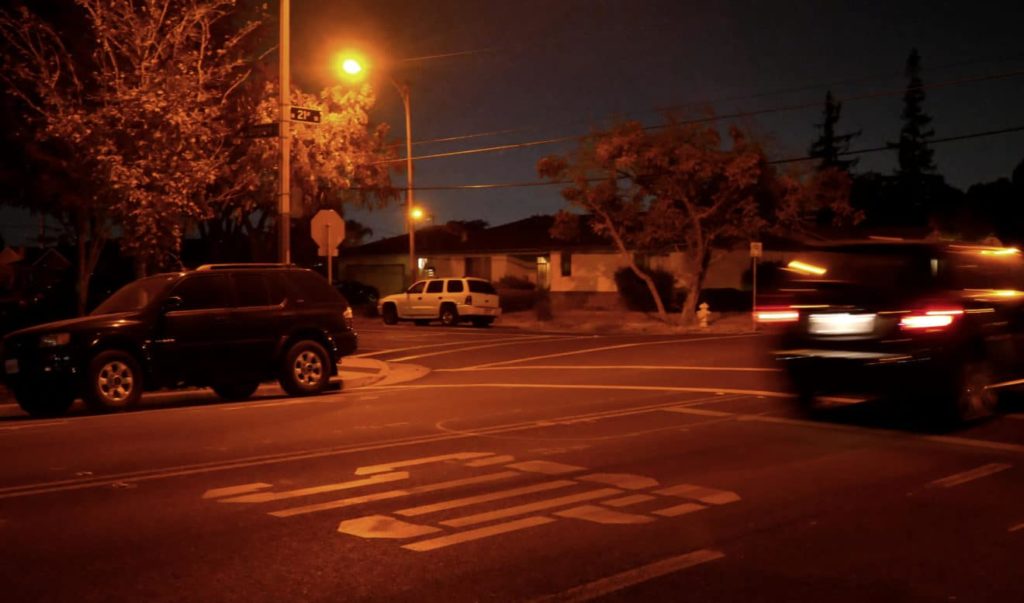A long history of reckless speeding, hit-and-runs and traffic-related deaths in San Jose’s Northside neighborhood has forced Tony Mangallanez to prohibit his kids from playing outside in the front yard.
“Drivers need to act like your kids are living on the street,” Mangallanez said. “I had a car that was totaled in front of my house. It was a scary thing – because if the kids had been out there, it could have been a different situation.”
Mangallanez joined 60 other residents at the Joyce Ellington Library on Monday night to discuss dangerous driving and traffic safety concerns amid a spike in development in the city’s urban core, including a massive downtown makeover spurred by Google, the expansion of BART and the transformation of Japantown.
Data from San Jose’s Department of Transportation shows 52 people died last year from traffic collisions in San Jose, up from 46 the year before. Between 2014 and 2018, there were 5,544 crashes in District 3 – which covers downtown San Jose – the highest of any district in the city.
These statistics are especially troubling since San Jose adopted the Vision Zero initiative in 2015, which aims for no traffic-related deaths annually through efforts like narrowing streets, upgrading crosswalks and improving bike lanes.
The meeting included Councilmember Raul Peralez, Transportation Director John Ristow, Assistant Fire Chief Reggie Williams and San Jose Police Department Captain Dave Santos. Organized by the Northside Neighborhood Association, residents hoped to find solutions for the safety issues, as well as prepare for increased traffic with the upcoming expansions and downtown redevelopment.
Peralez said his district has the most fatalities and major injuries, in addition to being home to the most car crashes. But the councilman said he’s strapped with a tight annual budget of $200,000 for traffic measures and past efforts to reallocate the funding based on need were unsuccessful.
“I live in the community just like all of you do right now,” Peralez said. “I would love to see our streets, especially our neighborhood, be ten times safer than they are today and have some of the best traffic calming measures, medians, bollards, more stop signs, you name it. Unfortunately, we know that’s not the reality.”
Since money – or lack thereof – is the issue, Peralez primarily recommended focusing on enforcement. The downtown lawmaker said he’s pressured the police department to add more motorcycle traffic enforcement officers, which now stands at just ten officers for the entire city.
The biggest push for increased enforcement, however, would come from residents filing out traffic enforcement request forms. According to SJPD, simply calling 3-1-1 doesn’t log complaints. Police officials said their database shows no accidents between 19th and 20th streets in the past 90 days, despite residents claiming Monday they had called during that time. The traffic enforcement request forms track a history of chronic traffic issues and notify enforcement officers, officials said.
Highlighting what has worked so far, Peralez referenced D3 Decides. The community participatory budgeting program has led to the approval of median island installation on North 21st Street by the Jackson and Empire Street intersections, costing $40,000. The islands are designed to narrow the appearance of an intersection, aiming to lower driving speeds.
Additionally, speed radar signs will be installed on North 11th Street, just north of East Taylor Street and on West Alma Street between Vine and South 1st Street. Those will cost $20,000 each.

But frustrated residents said Monday those measures aren’t good enough.
For example, speed bump installation is not an option in the Northside neighborhood, since emergency vehicles have to come to almost a complete stop. Neither are speed cameras, which don’t exist in San Jose.
But speed humps, which are shorter, could be an option. Ristow estimated the cost of speed humps for just one corridor to be around $80,000. A traffic signal in an intersection would cost closer to $1 million.
One resident suggested barricading off streets to block flow directly through the neighborhood’s grid of streets. Ristow said his department hadn’t considered that idea, but it has potential for wider community dissent. Similarly, more curbs could potentially be painted red to increase pedestrian visibility, but that could lead to drivers swerving around traffic in those newly-opened lanes.
Peralez committed to hosting another community meeting to discuss additional traffic safety solutions. He also encouraged residents to remain engaged by attending City Council committee meetings.
“You can help me prioritize. That continued pressure helps me in budgeting issues,” Peralez said. “That’s how it gets raised to a higher level of priority.”
Contact Katie Lauer at [email protected] or follow @_katielauer on Twitter.



Leave a Reply
You must be logged in to post a comment.